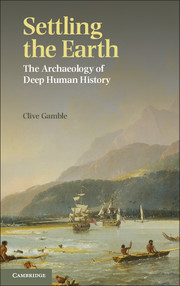Book contents
- Frontmatter
- Dedication
- Contents
- List of boxes
- List of figures
- List of tables
- Acknowledgements
- Glossary
- Web resources for skulls and stone tools
- 1 The worlds of deep human history
- 2 The drivers of climate and environment: Terrae 0–2, 10Ma–50ka
- 3 The recent veneers of climate, environment and population: Terrae 3–5, 50ka to the present day
- 4 Walking and running down the tectonic trail: Terra 0, 10–3.3Ma, and Terra 1, 3.3–1.8Ma
- 5 Three strides across a bio-tidal world: Terra 2, 1.8Ma–50ka
- 6 Going beyond, keeping in touch: Terra 3, 50–4ka
- 7 The call of the north: Terra 3, 50–4ka
- 8 Eyes on the horizon: Terra 4, 4–1ka
- 9 The human reunion in retrospect: Terra 5, after 1400 AD
- Bibliography
- Index
9 - The human reunion in retrospect: Terra 5, after 1400 AD
Published online by Cambridge University Press: 05 June 2014
- Frontmatter
- Dedication
- Contents
- List of boxes
- List of figures
- List of tables
- Acknowledgements
- Glossary
- Web resources for skulls and stone tools
- 1 The worlds of deep human history
- 2 The drivers of climate and environment: Terrae 0–2, 10Ma–50ka
- 3 The recent veneers of climate, environment and population: Terrae 3–5, 50ka to the present day
- 4 Walking and running down the tectonic trail: Terra 0, 10–3.3Ma, and Terra 1, 3.3–1.8Ma
- 5 Three strides across a bio-tidal world: Terra 2, 1.8Ma–50ka
- 6 Going beyond, keeping in touch: Terra 3, 50–4ka
- 7 The call of the north: Terra 3, 50–4ka
- 8 Eyes on the horizon: Terra 4, 4–1ka
- 9 The human reunion in retrospect: Terra 5, after 1400 AD
- Bibliography
- Index
Summary
And because there was nowhere to go but everywhere.
Jack Kerouac, On the Road, 1957Colonising Prospero’s Isle
Terra 5 is about many acts of reunion rather than a single age of discovery. It is a Terra of incessant colonisation with little to settle for the first time. Still uninhabited was the great polar continent, Antarctica, and several remote small islands in the South Atlantic: Ascencion, St Helena, Trindade and Tristan da Cunha. There were some also in the Pacific such as Christmas Island and Pitcairn that Europeans found empty but which archaeologists have shown to have been settled long before the ships arrived (Kirch 1984). Two uninhabited islands around Africa, the Cape Verde archipelago and Sao Tomé, were settled by Europeans in 1472 and 1486 AD. They mark a push beyond the western horizon. And before them came the settlement of the Azores, a chain of volcanic islands 1600 km to the west of Portugal, whose king, Henry the Navigator, is given credit for their settlement in 1427 AD. But despite Henry’s sobriquet, there are doubts he ever sailed there, or anywhere for that matter (Fernández-Armesto 2006: 127–129). Moreover, the Azores had been visited for more than a century prior to Portuguese settlement and, along with the Canary Islands, formed the stepping stones for 1492 and Columbus’ leap across the ocean.
Columbus marks a significant if unforeseen moment in the great human reunion – a colonial venture similar to the Leahy brothers’ expedition into the New Guineas Highlands (Chapter 1), since both encountered unexpectedly large populations. Before Columbus, a long history of two-way trade existed between the empires of the Old World and beyond. This trade went over land and over water, leaving behind Indonesian coconuts in Africa, Roman pottery in Cambodia, Viking trinkets in Baffin Island and Islamic coins in Britain. As a result, the haplogroups of Terra 4 were already being stirred before Columbus dropped anchor in the Bahamas.
- Type
- Chapter
- Information
- Settling the EarthThe Archaeology of Deep Human History, pp. 310 - 322Publisher: Cambridge University PressPrint publication year: 2013



